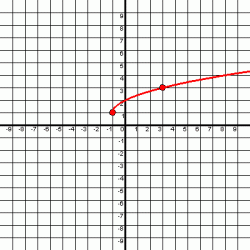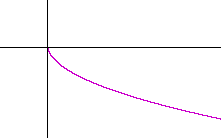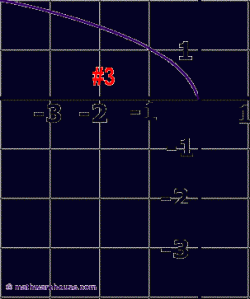Translations
The basic form for a square root function is f(x)=√ (x-a)+b.
A graph of a function in this form will start at the point (a,b), and will be the same line as √ x only the origin is translated from (0,0) to (a,b).
Example: f(x)=√ (x+1)+1
Here a=-1 and b=1. This means that the line will start from the point (-1,1) and continue on the same path as √ x.
A graph of a function in this form will start at the point (a,b), and will be the same line as √ x only the origin is translated from (0,0) to (a,b).
Example: f(x)=√ (x+1)+1
Here a=-1 and b=1. This means that the line will start from the point (-1,1) and continue on the same path as √ x.
Source: http://mathgraph.idwvogt.com/sqrt.gif
Reflections
When a negative sign is added to the front of the radical, it will reflect the graph over the line y=b. This will leave the graph with the same origin and shape, but it will be flipped upside down.
This is an example of the line f(x)=-√x. It looks just like the equation f(x)=√x only it is reflected over the line y=0.
This is an example of the line f(x)=-√x. It looks just like the equation f(x)=√x only it is reflected over the line y=0.
Source: http://www.themathpage.com/aPreCalc/Pre_IMG/A46.gif
If a negative sign is put in front of the independent variable inside the radical, then the graph is reflected over the line x=a. This will flip the domain around and the domain will go from (-∞,a]. The curve will look the same, only backwards.
Example: y=√(-x)
If a negative sign is put in front of the independent variable inside the radical, then the graph is reflected over the line x=a. This will flip the domain around and the domain will go from (-∞,a]. The curve will look the same, only backwards.
Example: y=√(-x)



